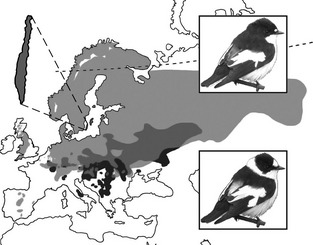Figure 1.

Pied and collared flycatchers. Collared (bottom right) and pied flycatchers (top right) are two small, short‐lived migratory passerines that winter in sub‐Saharan Africa and breed in Europe (Cramp and Simmons 2006). The two species diverged from their common ancestor less than one million years ago (Nadachowska‐Brzyska et al. 2013) and have probably gone through cycles of geographical isolation in separate refugia of the Mediterranean area during the ice ages followed by breeding range expansions northwards. The contemporary breeding range of pied flycatchers (light and dark grey) covers most of Europe, whereas the breeding range of collared flycatchers (black and dark grey) is restricted to warmer and more continental regions in Central and Eastern Europe and to the two Baltic islands, Gotland and Öland. Thus, differences in the overall breeding ranges of pied and collared flycatchers in Europe imply that collared flycatchers are relatively more limited by climate. Collared flycatchers therefore belong to the group of species that are expected to shift breeding range northwards in response to current climate change (Huntley et al. 2007). There are currently two contact zones: one broad hybrid zone in Central and Eastern Europe and one more isolated hybrid zone on the Baltic islands of Öland and Gotland, Sweden (both shown in dark grey). Our research is concentrated on the island of Öland that is enlarged (top left). The Swedish hybrid zone is relatively young and arose when collared flycatchers expanded their breeding range into areas where pied flycatchers were already present (Qvarnström et al. 2010). There is little divergence in size (Merilä et al. 1994), feeding techniques (Alerstam et al. 1978) or diet (Wiley et al. 2007) between the two species, leading to previous conclusions of a limited role of ecology in their speciation process. Moreover, both species breed in nest cavities (or nest boxes when provided) in deciduous forests leading to competition over nesting sites, which collared flycatchers are more likely to win (Qvarnström et al. 2010; Sætre and Sæther 2010).
